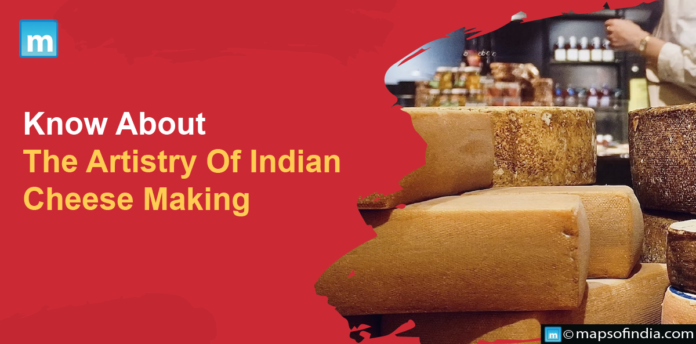Manufacturing cheese in India utilizing traditional methods and techniques is called artisanal cheese making. This often involves using local milk, hand-chopping curds, and maturing cheeses for an extended period. Artisanal cheese makers frequently create recipes and procedures, producing cheeses with distinct flavors and textures.
History
Cheese production in India has a long and varied history. The first evidence of cheese manufacturing in India dates back to the Indus Valley Civilization (3300-1300 BCE), where cheese molds and other dairy equipment were discovered. However, because dairy products have been an essential component of Indian cuisine for centuries, cheese manufacturing has likely been performed in India for even longer.
Process
Artisanal cheese production in India is often labor-intensive and done in small batches. The milk is pasteurized first, which destroys any hazardous microorganisms. After that, the milk is curdled with a natural coagulant, such as rennet or lemon juice. After that, the curds are separated from the whey, and the cheese is made. The cheese is then matured for some time, ranging from a few days to several months.
Types
The type of cheese made is determined by several factors, including the milk used, the coagulant employed, and the maturing time.
The following are some of the most frequent types of Indian artisanal cheeses:
Bandel cheese
This is a smoked and salt-cured cheese from West Bengal. It has a pungent, salty flavor and is prepared from buffalo milk. Bandel is frequently used in curries and other savory foods.
Chhurpi
This is a hard cheese created from the milk of a chauri (a male yak crossed with a cow). It is found in India and Nepal’s Himalayan area. Chhurpi has a pungent, salty flavor and is commonly consumed as a snack or in curries.
Kalari
This is a stretchy cheese from Jammu and Kashmir. It has a creamy flavor and is prepared from cow or goat milk. Kalari is frequently used in kebabs and other grilled foods.
Paneer
This is a curdled milk-based soft cheese. It is the most popular cheese in India and is used in various savory and sweet dishes. Paneer has a creamy texture and a mild, milky flavor.
In addition to these traditional Indian cheeses, artisanal cheesemakers in India produce European-style cheeses such as cheddar, gouda, and brie. These cheeses are manufactured using traditional procedures and techniques, but they are frequently made with locally sourced milk and herbs, giving them a distinctly Indian flavor.
The Relevancy of Indian Artisanal Cheese
Indian artisanal cheese is gaining popularity both in India and overseas. This is due to various causes, including increased interest in healthy eating, increased availability of artisanal cheeses, and the distinct flavors and textures of Indian cheeses. Artisanal cheeses are prepared in small amounts using traditional processes, resulting in better flavor and texture than mass-produced cheeses. They are also usually created with fresh, local ingredients, adding flavor. Aside from being delicious, Indian handmade cheeses are also high in protein and calcium. They’re also low in fat and calories, making them a good option for individuals watching their weight.




